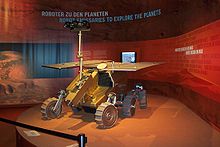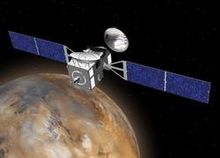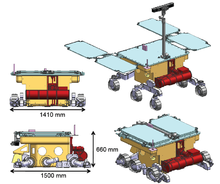ExoMars
ExoMars is a space probe project of the European Space Agency ESA in cooperation with the Russian space agency Roskosmos . The name stands for exobiology on Mars . After the US Viking probes in the 1970s, active research is to be carried out for the first time on past or even current life on Mars .
On March 14, 2016 at 9:31 UTC, the ExoMars Trace Gas Orbiter was launched from Baikonur by a Russian Proton rocket , which had carried Soviet probes to Mars as early as the 1970s . The ESA space probe with numerous instruments on board reached the orbit around Mars on October 19, 2016 as planned, but no contact could be made with the Schiaparelli landing probe, which was later released . In 2017, a failure of the control electronics was ultimately blamed for a hard impact and thus a total loss of the descent stage.
The ExoMars Rover will follow in 2022 . This mission - originally planned for 2018 - is also to be launched with a Russian Proton rocket. In addition to the two rockets, Roskosmos provides the landing unit for the rover as well as some measuring instruments on the rover itself. The missions are to be monitored by the European Space Flight Control Center (ESOC) in Darmstadt. The Rover Operations Control Center (ROCC) will be set up in Turin (Italy) to control the rover.
Objectives of the missions
The ExoMars program is intended to use important technologies with a view to future missions, including with regard to return of samples to Earth ( Mars Sample Return ). Important components are:
- The Entry, Descent and Landing Module (EDM) to successfully bring a payload to the surface of Mars
- Mobility on the surface using a rover
- Collecting samples on the surface
- Scientific examination of the samples
Scientific goals are:
- Search for past or current life on Mars
- Investigation of how water and the geochemical environment change
- Investigation of trace gases in the atmosphere and their sources
ExoMars Trace Gas Orbiter
The ExoMars Trace Gas Orbiter mission was launched on March 14, 2016 with a Russian Proton rocket . It initially consisted of an orbiter, which is supposed to examine trace gases such as methane in the Martian atmosphere, as well as the Schiaparelli lander , with which the landing on Mars should be tested. After the lander detached from its mother ship, the orbiter successfully entered orbit around Mars on October 19, 2016. During the landing of the lander on the same day, radio contact with Schiaparelli was broken off shortly before the expected time of landing and could not be re-established. The ESA suspects that Schiaparelli switched off the engines to slow them down at an altitude of two to four kilometers. From there, the lander fell towards Mars at about 300 kilometers per hour. On impact, the fuel tanks could have exploded, which were most likely still full. Images from NASA's Mars Reconnaissance Orbiter (MRO) show the crash site of the lander and the parachute about 1 kilometer south of it.
However, the failure of the landing had no fundamental consequences for the dropping of the European ExoMars rover, which was planned in 2020. On December 2, 2016, ESA released the required funds.
ExoMars landing platform and rover
A landing platform (built by Roskosmos) and a rover (built by ESA) are planned for the year 2022 , with which the surface of Mars will be examined in detail. The launch was initially announced for 2018, but was postponed to July 25, 2020 in May 2016 due to "delays in industrial activities and the delivery of the scientific payload". After two failed parachute tests in May and August 2019 and further delays in the development of the spacecraft, ESA announced another postponement to 2022 in March 2020. There are two 10-day start windows to Mars from August to October 2020.
The most important instrument is a drill with which samples can be obtained from a depth of up to two meters. The samples obtained in this way are not affected by the recent erosion of the surface and can therefore provide an insight into the history of Mars. Here, too, an investigation into past or current life as well as geochemical activities is the most important goal of the mission.
Landing procedure
The landing platform and rover land as a unit on Mars. It is currently planned to land with two parachutes. The first triggers at supersonic speed and the second after slowing down to subsonic speed. The heat shield is then thrown off and the final, soft landing on the surface of Mars is carried out with the braking rockets on the underside of the platform.
After landing, the rover will drive off the platform via a ramp and begin its work, while the landing platform has its own scientific instruments. So the orientation and rotation of Mars is to be observed with radio waves (LaRa experiment) that go through the planet. This allows a change in the movement of the Martian rotation to be recognized, for example due to shifts in the mass of the ice caps at the Martian poles. The temperature, humidity and UV radiation during the different seasons of Mars are also monitored.
History of planning

ExoMars began as a purely European project and has been significantly changed over the years. While initial planning was based on a launch in 2009, consideration was given to launching the rover in 2011 with a Soyuz 2 rocket from Kourou over a longer period of time . The landing should take place two years later (2013). In November 2006, ESA postponed the start date to 2013 in order to have more time to develop key technologies. The trip to Mars should now only take a year and the landing should take place in 2014. In autumn 2008, ESA announced another postponement to early 2016. The cost of the mission was originally supposed to be around 650 million euros.
The launch mass of the space probe, consisting of a flyby probe and a lander , should be 1,500 kg, of which the landing module accounts for around 850 kg. The six-wheeled rover itself should be about 1.6 m long, 1.2 m wide and 250 kg heavy, which is about the size of a MER rover. The vehicle should be equipped with a total of 18 solar-powered motors and 27 sensors and be able to drive largely autonomously at a speed of up to 100 meters per hour over the surface of Mars and inspect the surface of Mars for several months. Soil samples should be taken from a depth of up to 2 m using a drill at different points. The space probe was to be built at Alcatel Alenia Space . At the meeting of the European Space Council in December 2005, it was decided to finance the probe, in which Germany will contribute 86 million euros. In this context, wheels for the rover have been developed by the German Aerospace Center in Cologne-Porz since January 2006 .
In 2006, thought was given to launching an orbiter instead of the flyby probe . This would allow communication with the earth independent of NASA space probes (especially MRO ) as well as the transport of a payload package weighing around 30 kg into Mars orbit. But in order to be able to launch an additional orbiter, the launch would have had to be done with an Ariane 5 . This would have required an additional 175 million euros for the development of the orbiter and the more powerful launcher.

The upper limit of 1 billion euros for orbiters and rovers set by the member states of ESA could not be adhered to, which is why a cooperation was negotiated with NASA . The concept from 2009 included a NASA orbiter to study the atmosphere of Mars and two rovers: the NASA MAX-C (Mars Astrobiology Explorer-Cacher) rover and the European ExoMars rover. The Trace Gas Orbiter was to take off together with a small lander (Entry, Descent and Landing Demonstrator Module (EDM)) in 2016 and the two rovers in 2018 with an Atlas V from Florida. The small lander carried by the orbiter, although barely equipped with scientific instruments, was intended to demonstrate ESA's ability to land softly on another planet. Similar to the Rover Curiosity, the two rovers should land on a Sky Crane and then complete their missions independently of each other.
A report (Planetary Science Decadal Survey 2013–2022) by the National Academy of Sciences in early 2011 and the cost estimate made major savings measures necessary. The MAX-C rover had to stay within a budget of $ 2.5 billion. This would only have been possible if the landing system from Curiosity had been adopted almost identically. This restriction would only have allowed one rover. A combined MAX-C Exomars Rover concept should now be worked out by the end of 2012.
In September 2011, NASA announced that it did not have the funds to launch in 2016. As a result, ESA started negotiations with Roskosmos in order to win Russia as a project participant. Discussions were about launching a Proton rocket in 2016 , for which Russia will provide payloads and access to scientific data in return.
In the 2012 published budget of NASA for 2013 it was explicitly decided to end any involvement of NASA in the ExoMars project. The cooperation between ESA and Roskosmos should still make the two missions for 2016 and 2018 possible.
In order to extend the previously planned mission duration of the landing capsule of the ExoMars Trace Gas Orbiter from several days to a year after landing, the use of radionuclide batteries was even considered at times .
On March 14, 2013, ESA signed a contract with Roskosmos to carry out both missions. The ESA states are building the lander EDM and the TGO orbiter. They were launched together on board a Proton rocket in March 2016. For 2018 Russia is building the descent module with surface platform for the Exomars rover. The ESA states are building the transport module and the ExoMars rover.
The US and EU sanctions imposed on Russia in the wake of the Crimean crisis in 2014 should not delay the project. However, components provided by the USA could be delivered to Russia late.
Concept from 2004
The scientific payload, originally called Pasteur , was supposed to contain several instruments to study the various aspects of the Martian environment. The concept was later changed.
- Panoramic instruments
- Contact instruments
- Ma-MISS - IR spectroscope on the drill
- CLUPI - a microscope
- Analytical laboratory instruments
- RLS - a Raman spectroscope
- MicrOmega - an IR spectroscope
- MOMA - a laser desorption MS with a GC-MS
- Mars-XRD - X-ray spectroscope
- LMC Life Marker Chip - Detection of traces of possible past or present life
Concept from 2012
In 2012 the choice of instruments was changed in order to be able to cope with a significantly smaller rover after NASA withdrew. Compared to the concept from 2004, the two last-named instruments Mars-XRD and LMC have been replaced by two Russian instruments.
- Panoramic instruments
- PanCam and WISDOM
- Contact instruments
- Ma-MISS and CLUPI
- Analytical laboratory instruments
- RLS, MicrOmega and MOMA
- Russian instruments
- Infrared Spectrometer for ExoMars (ISEM)
- Adron - neutron spectrometer
costs
As of 2016, the costs of ExoMars are given by ESA alone at over € 1.3 billion. According to Roskosmos, according to data from 2012, there will also be 1.4 billion US dollars for the Russian investment.
Up until the announcement of its withdrawal in September 2011, NASA was at least conceptually involved, providing individual components that fly with it. These costs are not known.
See also
Web links
- ESA - The ExoMars Program 2016–2018 (English)
- Web site ExoMars (English)
- EXOMARS PROJECT 2018 Mission (English, PDF; 5.9 MB)
- Background information on ExoMars on the ESA website (German)
- DLR: The landing site of Schiaparelli, landing module of the ESA ExoMars 2016 mission, on Mars 11 August 2016
- Schiaparelli crash site of Nasa photographed (English)
Individual evidence
- ↑ Conclusion of contract: Europeans and Russians fly together to Mars. Spiegel Online, accessed March 14, 2013 .
- ↑ Stephen Clark: ExoMars team has long wait to confirm launch success. SpaceflightNow, March 14, 2016, accessed March 14, 2016 .
- ↑ Schiaparelli descent data: decoding underway. (No longer available online.) ESA, October 20, 2016, archived from the original on October 21, 2016 ; accessed on October 21, 2016 . Info: The archive link was inserted automatically and has not yet been checked. Please check the original and archive link according to the instructions and then remove this notice.
- ^ Schiaparelli landing investigation completed. ESA, May 24, 2017, accessed July 23, 2017 .
- ↑ a b N ° 6–2020: ExoMars to take off for the Red Planet in 2022 . ESA, March 12, 2020.
- ↑ Conclusion of the contract: The ExoMars programs 2016–2018. ESA, accessed January 1, 2016 .
- ↑ ExoMars Mission (2018). ESA, accessed January 11, 2016 .
- ↑ Europe moves ahead with Mars mission, kills asteroid lander. On: sciencemag.org of December 2, 2016
- ↑ Full go-ahead for building ExoMars 2020. ( Memento of the original from December 18, 2016 in the Internet Archive ) Info: The archive link was inserted automatically and has not yet been checked. Please check the original and archive link according to the instructions and then remove this notice. On: esa.int of December 16, 2016
- ^ Esa: Second ExoMars mission moves to the next launch opportunity in 2020. In: European Space Agency. Retrieved May 2, 2016 .
- ^ Russian Launch Manifesto. (TXT) December 30, 2018, accessed December 31, 2018 .
- ↑ Jonathan Amos: Europe's 'seven minutes of terror' . In: BBC News . June 21, 2013 ( bbc.com [accessed May 5, 2018]).
- ↑ ExoMars 2020 surface platform. Retrieved May 5, 2018 (UK English).
- ↑ European Mars launch pushed back , BBC News, November 10, 2006
- ↑ Thorsten Dambeck: Europe's planetary research is establishing itself , report from the EPSC conference in Münster, NZZ of October 29, 2008
- ↑ Mission ExoMars: The Swiss are there. 20minuten Online, December 10, 2009, accessed April 21, 2010 .
- ↑ Mars is getting closer , FliegerRevue, September 2008, pp. 43–46
- ↑ UK announces £ 1.7 million Aurora spend for Exomars mission , Flight International, July 5, 2006
- ^ Europe's Mars missions get final go-ahead , BBC News, December 20, 2009
- ^ Robot scientist's parliament trip , BBC News, March 5, 2010
- ↑ ExoMars Rover and MAX-C ( page no longer available , search in web archives ) Info: The link was automatically marked as defective. Please check the link according to the instructions and then remove this notice. , December 7, 2010
- ↑ Mars 2018 Joint Rover Mission: Report from Joint Engineering Working Group (JEWG) (PDF; 1.5 MB), June 16, 2011
- ↑ NASA Cannot Launch 2016 ExoMars Orbiter , SpaceNews, September 30, 2011
- ↑ Russia could join ExoMars as full partner. On: marsdaily.com , December 12, 2011
- ↑ NASA drops ExoMars missions in 2013 budget. Optics, February 15, 2012, accessed February 15, 2012 .
- ↑ Jonathan Amos: ExoMars cooperation between Nasa and Esa near collapse. BBC News, February 6, 2012, accessed February 6, 2012 .
- ↑ Alexander Stirn: Marsforschung, Europe's difficult path to Mars in Spektrum.de, May 22, 2012, accessed on May 24, 2012
- ↑ ExoMars: ESA and Roscosmos ready to start their Mars mission , in ESA Germany, March 14, 2013, accessed on March 15, 2013
- ↑ Staff Writers: Europe, Russia ink deal on double mission to Mars , in marsdaily.com, March 14, 2013, accessed March 15, 2013
- ^ Jeff Foust: European Mars mission caught in US-Russia tensions. In: spacepolitics.com. May 17, 2014, accessed January 17, 2015 .
- ↑ http://esamultimedia.esa.int/docs/Aurora/Pasteur_Newsletter_4.pdf
- ↑ The ExoMars Newsletter August 2012
- Jump up ↑ Space: ExoMars: United on the Way to Mars. ORF.at, March 12, 2016, accessed on March 13, 2016 .
- ↑ Russia and Europe agree on Mars project. Russia Beyond The Headlines, April 16, 2016, accessed March 13, 2016 .




